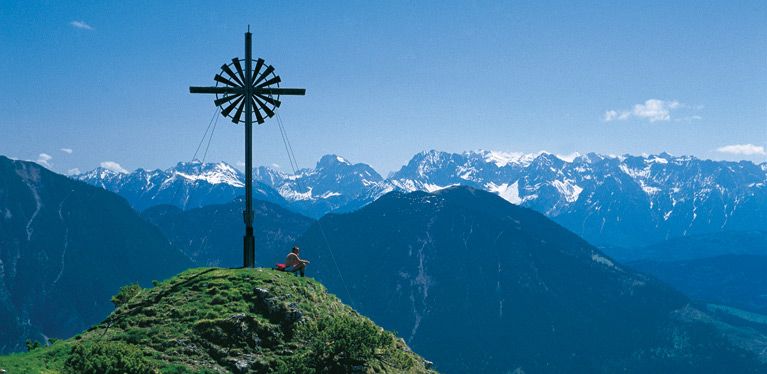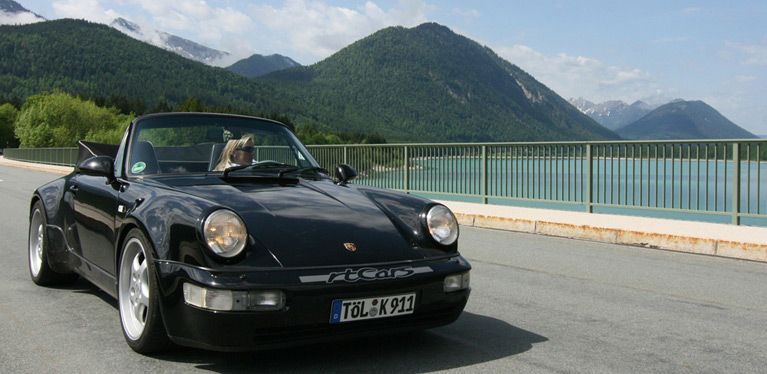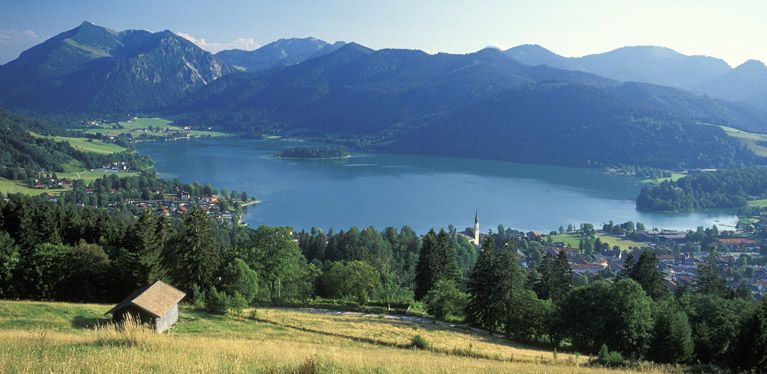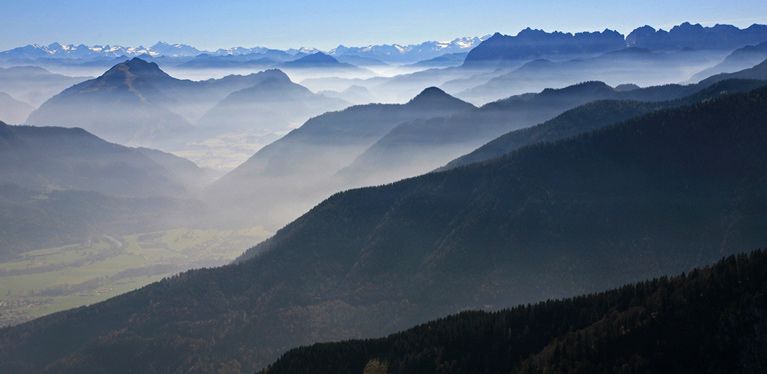German Alpine Route
German Alpine Route
Lake Constance to the Watzmann mountains.
The Alps: green meadows, jagged peaks, crystal-clear lakes and gently undulating foothills. A magical blend of pristine natural beauty, age-old traditions, hearty regional delicacies and state-of-the-art tourist infrastructure.No surprise then, that this was the birthplace of Germany’s first scenic tourist route. It’s the unique combination of outstanding scenic beauty and ultimate test of driving skill that makes the German Alpine Route so special and where you can genuinely say it’s more about the journey than the destination.
We’ve picked out a few of the special highlights for you along this 450-kilometre drive.
It goes without saying, but any wine stops detailed on this page are for the benefit of hire car passengers ... designated drivers must confine themselves to drinking in the scenery. Book a hire car now and explore Germany
Lindau and Lake Constance
Lindau is a historic harbour town on the shores of Lake Constance and really isn’t the best starting point for this trip ... it’s the kind of place you’d like to stay for a while. Located a stone’s throw from the Austrian border and built on an island, sun-splashed Lindau has a distinct Mediterranean vibe as you stroll along the quaint narrow streets of the old town.Lake Constance gives Lindau this Riviera-like feel and has a big and beautiful backdrop, totalling around 536 sq. kilometres. So, before pulling on the driving gloves and heading off on the B308, savour an espresso as your gaze wanders from the harbour entrance with the Bavarian lions and the lighthouse across the lake to the Swiss Alps in the distance.


Across the Allgäu
The first step takes you on the B308 from Scheidegg to Immenstadt, with fine views across the foothills of the Allgäu. That soon becomes a lovely memory as you negotiate the Rohrach hairpins and the nine percent incline on the approach to the amazing Scheidegg waterfalls.Continuing on towards Oberreute, small villages and rustic hamlets dot the landscape. Look out for isolated farmhouses and marvel at the spectacular, ever-changing vistas of the Nagelfluh Alps and the Vorarlberg Alps further to the south.
Then you reach the stunning, alpine Oberstaufen, where you can stop to ski, hike, sled or play golf. You may want to mark 18 May in your calendar as this is when the 18-day Allgäu-Orient-Rally to Jordan starts every year from here.
The drive to the Alpsee lake just outside Immenstadt isn’t quite as challenging. If you’ve brought the kids, let them expend some energy in the biggest rope-climbing centre in Bavaria and the thrilling three-kilometre year-round sled run at the Alpsee Mountain Resort. Immenstadt is a former seat of nobility and a gentle stroll around the impressive old town castle is recommended, as is a visit to the nature centre with its unforgettable mountain scenery.
Travel tip: Drive the Oberjoch Pass
Crossing the Oberjoch Pass from Bad Hindelang to Füssen via Nesselwang is an ambitious undertaking and one of the more complex challenges facing drivers, but all part and parcel of the unique character of the German Alpine Road.This leg in the Allgäu Alps is the curviest road in Germany, with 106 hairpins to negotiate, so keep a firm grip on the wheel and one eye on the road while the other marvels at the stunning Alpine scenery. Gravity prevails as you near Füssen and several historical sites lie in wait for the eager culture vultures on board.


Füssen and the royal palaces
A boat trip is a must-do on one of the 10 or so lakes around this town along the River Lech; try the turquoise waters of the Forggensee in the shadow of the nearby peaks.After admiring the old town with its medieval patrician houses and baroque churches from the vantage point of one of the pretty street cafés, it comes as no surprise to find that the Romantic Route goes straight through Füssen. This also serves as a starting point for visits to a number of Germany’s most famous attractions: the castles of Neuschwanstein and Hohenschwangau overlook Alpsee lake above the town.
The road takes you deep into the dark forests of the Ammergau nature conservation area. Schloss Linderhof is like a magical apparition in the Graswang valley. This route is a short-cut to the Garmisch-Partenkirchen area, while the Alpine Road follows route B17 from Füssen, traversing the Pfaffenwinkel region past fertile meadows and old farmhouses.
Ammergau Alps and Garmisch-Partenkirchen
Leaving Pfaffenwinkel behind, follow the B23 along the edge of the mountains of the Ammergau to Garmisch Partenkirchen, the next stop on the route. This leg starts off at a height of 80 metres, on the Echelsbacher Bridge above the River Ammer.Following the river, you soon reach Oberammergau, the world-famous home of the iconic Passion Play. The quaint painted houses and woodcarving workshops dotted around the centre exude charm and speak of centuries of tradition; it’s even possible to watch woodcarvers going about their business.
A few minutes of easy driving brings you to Ettal, where the Benedictine Abbey will tempt you to rest and enjoy the superb architecture and in-house brewery, distillery and cheese making facility.
This stage of the route comes to an end in Garmisch-Partenkirchen. This is a town with an outstanding sporting heritage and is your gateway to the thrills and excitement of downhill skiing on Germany’s highest peak, the 2,962-metre Zugspitze, part of the Wetterstein range. Feel free to plan a few days in this sports paradise and try some canoeing, hang-gliding, mountain biking or if you dare, a climbing tour on the north face of the Alpspitze, the iconic symbol of the town.


The lakes around Bad Tölz
If you head south from the baroque-inspired spa town of Bad Tölz, the B11 and B13 join up to link a chain of lakes that glitter like diamonds in the sun, the Walchensee, Kochelsee and man-made Sylvensteinsee.The Walchensee lies directly underneath Herzogstand, the closest mountain to Munich. What is amazing about this lake, and the Sylvensteinsee too, is the way the mountains seem to come straight out of the water, like a Scandinavian fjord. This quality wasn’t lost on the producers of the Viking Saga Wickie or other films and you can check out the lakeside film sets in the imaginary village of Flake.
You’ll need the driving gloves again to master the Kesselbergstraße up to the Kochelsee. With a four-percent gradient and nothing but curves, it was previously used for car and motorbike races.
Tegernsee and Schliersee
The B307 from Kreuth to Bayrischzell gives you another chance to savour majestic lakeside scenery. Pretty Wildbad Kreuth on the banks of the Weißbach river is the perfect starting point. Partly because a highly-regarded chamber music festival is held here every August, but also because an equally highly-regarded cheese is made here, the high-quality “haymilk cheese”, which will sustain you on your upcoming journey.Just after Rottach, you will spot the famous Tegernsee lake. A traditional “let’s get out of the city” destination, the recreational infrastructure is well-developed and could keep you busy for a few days.
Continuing east, you glimpse the Schliersee and the Marcus Wasmeier Outdoor Museum, an authentic re-creation of rural Bavarian village life as it used to be. Bayrischzell oozes rustic charm … while you’re there, make sure you follow the winding road up to the Sudelfeld and take in the stellar panorama of the Mangfall mountains.


The Chiemgau – all around the Chiemsee
The best starting point for your Chiemgau crossing on the B305 is the cable car station at the foot of the spectacular Kampenwand near Aschau. Eight enchanting kilometres later you arrive at Chiemseepark-Felden, ready for the short boat trip out to the Heereninsel where Herrenchiemsee Castle, one of King Ludwig II’s masterpieces, awaits you.Unterwössern is where the road starts to get your attention again. If you enjoyed the white-knuckle experience on the Oberjoch Pass, then you will be equally impressed by the roads at the Walchensee and the Maseralm by Reit im Winkl. The road up to the Maseralm has the honour of being the steepest on the German Alpine Road, with a 12% incline.
After making it to the top at 797 metres, test your climbing and balancing skills in the climbing garden, with high-rope action, rope bridges, tightropes and balancing beams, in an idyllic woodland setting.
Berchtesgaden – paradise found, for nature-lovers and drivers too
The German Alpine Road ends in style … the last leg takes you to the remote but stunning Königsee lake, where you are immediately taken by its unique, mysterious charm. As soon as you glimpse the wild beauty of Königsee gorge on the B305 near Weißbach you can feel its magical pull.The road continues along the rugged beauty of the Reiteralp ridge, before the steep climb up to the Schwarzbachwacht (868 metres). Then it’s paradise found in the idyllic Berchtesgaden National Park with its stellar vistas and your first view of the towering peaks of the Watzmann mountain ahead. Get the cameras ready for the church coming up just below the saddle; if you’re in the mood, take a quick detour to Hintersee and the Sankt Sebastian church in Ramsau, a memorable highlight of your Alpine Road adventure.
Heading towards Berchtesgaden, take a quick break to stretch your legs and admire the wild and wonderful waters of the Wimbachklamm gorge. Or relax with a gentle stroll through the historic centre of Berchtesgaden. Alternatively pull on your driving gloves again and try the Rossfeld Ringstraße east of town, a challenging and scenic route.
If hiking’s your thing, head straight for Schönau on Königssee and glide quietly across the pristine water by electric boat to the pilgrimage church of St. Bartholomew. After sampling the delicious Königssee trout, hike up to the small Obersee lake framed by mountain peaks. Here you can take a guide and conquer the legendary East Face of the Watzmann and from the top, look back along the 450 kilometres of peaks and valleys of the Alpine Road, indelibly burned in your memory.
